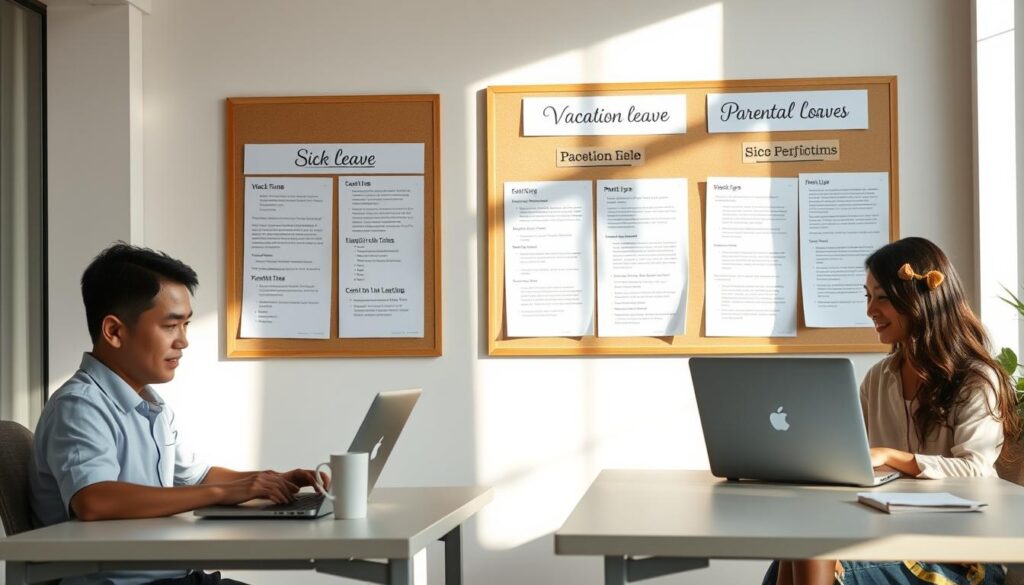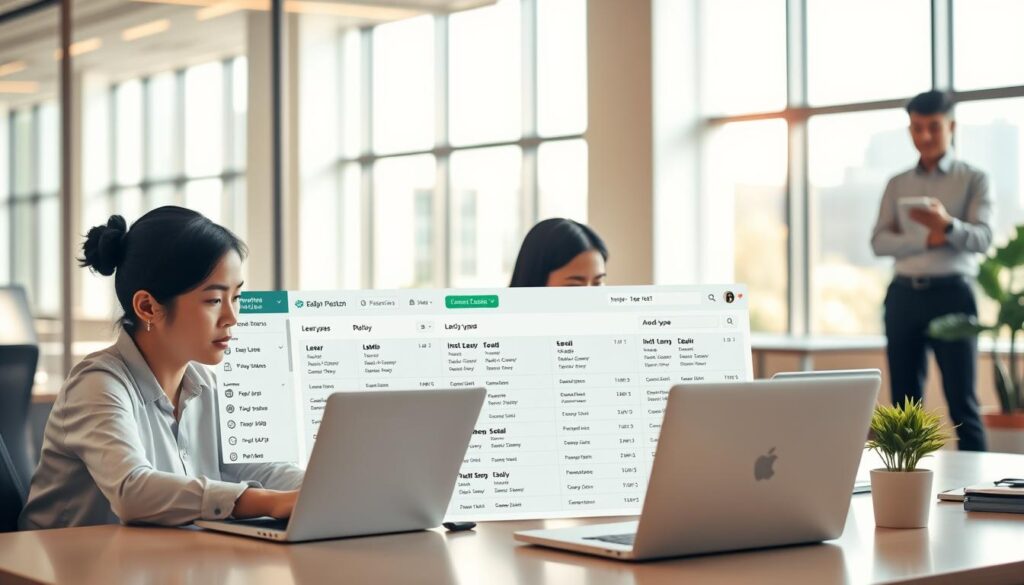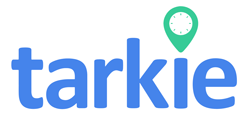Ever thought about how sick, vacation, and parental leave affect work happiness and productivity? Knowing how to manage leave is key for employers and employees, more so in the Philippines. It’s important for keeping workers happy and following the law, making the workplace better for everyone.
Companies must handle sick leave rules and vacation plans carefully. A good leave system boosts benefits, keeps workers longer, and makes everyone more productive. Clear policies and technology help avoid misunderstandings, making the team more united. With smart strategies, businesses can thrive in today’s tough market.
Key Takeaways
- Understanding various types of leave enhances employee satisfaction.
- Legal compliance is essential in managing leave effectively.
- Structured leave policies can reduce employee absenteeism substantially.
- Technology aids in accurately tracking leave, improving HR efficiency.
- Effective communication of leave policies minimizes confusion and maximizes utilization.
Understanding Leave from Work
Leave from work means time off during regular hours for reasons like vacations, illness, or personal issues. It’s key for small to medium enterprises (SMEs) in the Philippines to know about leave management. This helps them create good leave management policies. It makes sure employees get the paid time off they need, creating a healthy work environment.
Having good leave policies can really help with employee happiness and work quality. For example, enough paid time off helps employees relax and prevents burnout. This is good for the company. It’s important for companies to clearly share their leave policies. They should also make sure employees know their rights and duties when taking time off.
Employees face different situations that need their attention. So, it’s important to offer various leave options. Knowing about leave management helps meet employee needs with care. For more tips on managing stress and leave, check this informative resource.
By focusing on a solid leave structure, companies can boost morale. They create a place where employees feel important and supported. Understanding leave is a key part of running a productive business.
Types of Leave: Sick Leave, Vacation Leave, and Parental Leave
Knowing about different leave types helps employees plan their time off wisely. Each type has its own purpose and fits into the company culture and policies. The main types are sick leave, vacation leave, and parental leave.
Definition and Purpose of Sick Leave
Sick leave lets employees take time off to get better without losing pay. It’s key for keeping a healthy team. In the Philippines, most companies offer paid sick leave to support their workers.
Importance of Vacation Leave for Employee Well-being
Vacation leave is crucial for mental health and work-life balance. It helps employees recharge and come back to work refreshed. Companies that value vacation days show they care about their employees’ well-being.
Understanding Parental Leave and Its Impact
Parental leave is vital for new parents to spend time with their babies. It includes both maternity and paternity leave. Companies that offer good parental leave policies help keep their employees happy and loyal.

| Type of Leave | Purpose | Typical Duration |
|---|---|---|
| Sick Leave | Time off for illness or injury | Varies by company policy |
| Vacation Leave | Time off for rest and recreation | Typically set by company vacation policy |
| Parental Leave | Time to bond with a new child | Up to 52 weeks for maternity, 2 weeks for paternity |
Legal Requirements for Leave in the Philippines
The Labor Code in the Philippines sets rules for leave. Employers must follow these to protect employee rights and avoid fines. It’s important for both sides to know about sick leave and vacation days.
Mandatory Sick Leave Policies
Employees in the Philippines get at least five days of paid sick leave after a year. This helps them not worry about money when they’re sick. Many companies give even more sick days, up to 15, to show they care.
Following sick leave laws is key for a fair workplace. It builds trust with employees.
Vacation Leave Entitlements
Employees also get vacation days that are legally required. The law says they must get at least five paid vacation days a year. But, many employers give 15 days or more.
Offering more vacation days makes employees happier and more loyal. It helps keep a good work atmosphere. Employers should check their vacation policies often to meet their team’s needs.
Effective Leave Management Strategies
Good leave management boosts productivity and happiness at work. Companies with clear leave policies are more efficient and happier. They focus on three key areas: making a leave policy, using tech for tracking, and sharing these policies well.
Creating a Leave Policy
A detailed leave policy is key. It should cover different leave types, who can take them, and how to ask for time off requests. Being open about these rules makes things fair and helps employees feel part of the team. Studies show that clear policies can make employees 25% happier and more likely to stay.
Using Technology for Leave Tracking
HR software for leave tracking makes things easier. It cuts down on paperwork by 40%. It also makes sure leave is tracked right, cutting down errors by 90%. This keeps records accurate and avoids legal issues. It also helps reduce no-shows by 25%.
Communicating Leave Policies to Employees
Telling employees about leave policies builds trust. When they know their leave rights, they feel more connected. Research shows that clear policies make employees 35% happier. Reminding them about unused leave can also cut down on unused days by 20%.

| Strategy | Benefits | Statistics |
|---|---|---|
| Creating a Leave Policy | Improves employee engagement and morale | 25% increase in retention |
| Using Technology for Leave Tracking | Reduces administrative tasks | 40% decrease in workload |
| Communicating Leave Policies | Enhances employee satisfaction | 35% higher satisfaction rate |
Employee Benefits Associated with Leave Types
Good leave management boosts employee benefits in companies. Offering different types of paid time off shows you care about your team’s well-being. It also makes the workplace a better place to be.
Happy employees do their jobs better and stay loyal. This is because they feel valued and supported.
Enhanced Employee Satisfaction
Having various leave options makes employees happier and more positive. When they feel their health and personal lives matter, they’re more satisfied at work. A good leave system makes it easy to request and approve time off.
This reduces stress and makes the team more engaged. It’s a big step towards a better work environment.
Attracting Top Talent with Competitive Leave Policies
In the Philippines’ job market, companies with great leave policies attract the best talent. Job seekers look at benefits like leave policies when choosing where to work. A strong leave management system shows you support work-life balance.
It makes your company stand out in hiring and keeping employees. Clear and fair leave practices are key to success.
Challenges in Leave Management
Organizations face many challenges in leave management. These issues affect both following the law and keeping employees happy. They must deal with keeping up with labor laws, tracking leave, and managing absences well.
Maintaining Compliance with Labor Laws
Small and medium-sized enterprises (SMEs) must follow local labor laws closely. Over 90% of HR experts say clear records are key to avoiding legal trouble with leave requests. Not following the rules can lead to big legal problems and harm a company’s image.
Tracking Leave Accurately Across Departments
Keeping track of employee leave is hard, mainly when there are more people and more leave requests. Studies show that 60% of HR pros say old tools and mistakes hurt their leave tracking. Companies using old ways see more disputes over leave, showing the need for a good system.
Employees often don’t know how much leave they have, making tracking harder.
Managing Employee Absences Effectively
Dealing with absences can be tough, needing careful planning to keep enough staff. HR teams spend more than five hours a week on leave requests, leading to frustration. Using automated systems can cut down on this time by half.
A good leave management system makes employees 25% happier. It gives them the clear information they need for planning.
Best Practices for Managing Sick Leave
Managing sick leave well is key for a company’s success and employee health. Clear rules help in keeping records right and make a safe space for reporting sickness. These steps help follow the law, make employees happy, and create a caring work place.
Documentation and Record Keeping
Keeping accurate leave records is very important. It helps companies follow the law and avoid confusion. A good system for keeping records helps track sick leave and shows who has taken leave before.
It’s important for employees to give the right papers, like doctor’s notes, for long absences. This proves they were sick and helps plan for work later.
Creating a Culture that Encourages Reporting Illness
It’s important to have a place where people feel safe talking about their health. When they do, it helps everyone stay healthy. This way, sickness doesn’t spread as much.
Talking about the value of sick leave and offering help programs can make this culture stronger. It makes sure employees know their rights and duties when it comes to sick leave.
Vacation Leave: Policies and Planning
Creating a clear vacation policy is key for any company. It shows how to handle vacation requests and makes sure employees get the most from their benefits. A good plan for managing time off helps create a supportive work place. This can make employees happier and more satisfied with their jobs.
How to Approve and Manage Time Off Requests
It’s important to have a smooth way to approve time off. Companies should have clear rules that are fair for everyone. This might include setting deadlines for when to ask for time off and when to get an answer.
Using software to manage leave can help avoid mistakes and make things more efficient. It ensures all employees are treated fairly when it comes to time off.
Importance of a Clear Vacation Policy
A clear vacation policy stops confusion about vacation time. When employees know their rights and the policy, it builds trust and respect. It also helps keep employees engaged and loyal by explaining how vacation time is given out.

Parental Leave: Supporting New Parents
Helping new parents through good parental leave policies is key to a healthy work place. It’s important for employees to know their rights to maternity, paternity, and family leave. Employers should support and respect these rights.
Overview of Maternity and Paternity Leave Rights
In the Philippines, moms get at least 105 days of maternity leave. Dads get 7 days of paternity leave. But, about 70% of workers don’t know their company’s leave options. Making sure everyone knows about these rights builds trust and happiness at work.
Encouraging a Supportive Work Environment for Parents
Helping parents get back to work smoothly is crucial. A big 60% of new parents want flexible work options. Giving these options shows a company cares about balance and keeps employees happy for longer.
Reviewing family leave policies often keeps a company’s image good and shows it cares about society. This is good for business.
Integrating Leave Management into HR Practices
Adding leave management to HR practices boosts productivity and morale. A smooth process makes tracking easier and helps follow company rules. Companies that focus on leave management see big benefits, making the workplace better.
The Role of HR Software in Leave Management
HR software is key for leave management. It makes tracking leaves and keeping records better, leading to clearer communication. With these systems, businesses cut down on paperwork and payroll mistakes.
Employees can handle their leave online, which cuts down HR’s work. This builds trust and openness in the workplace.
Evaluating Leave Trends for Strategic Planning
Checking leave trends helps plan better for the future. By looking at attendance, companies can predict when they’ll need more staff. This helps reduce absences and makes employees happier.
About 60% of workers feel more connected when leave is handled well. Using data helps make leave policies better and plan the workforce ahead. This keeps productivity up and stress down.

Conclusion
Effective leave management is key to boosting employee benefits and productivity. It helps businesses in the Philippines create a motivated team. By using automated systems, leave approval becomes smoother and records more accurate.
Employee well-being is now a top priority for companies. With 99% of U.S. businesses offering paid leave, Philippine SMEs can follow suit. This makes them more attractive to top talent looking for good leave options.
Using technology for leave management makes work environments fair and supportive. It keeps employees happy and engaged. This is crucial for tackling today’s workplace challenges.
